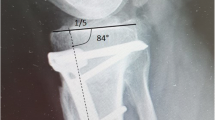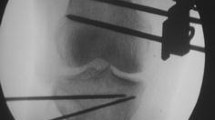Abstract
In recent years there has been a renewed interest in high tibial osteotomies (HTOs). The development of new instruments and better fixation devices has significantly simplified the surgical procedure. This technique is frequently used to correct alignment in the frontal plane. However, changes in the sagittal plane following closed wedge HTO have not been appropriately investigated. Hence, the purpose of this study was to investigate any possible alteration of the tibial slope introduced by closed wedge HTO. In addition, we also investigated whether there is a correlation between changes of the frontal plane and alteration of the tibial slope in the sagittal plane. In a retrospective study, radiographs of 67 patients (41 males, mean age 36.6 and 26 females, mean age 39.4 years) who underwent a closed wedge HTOs or removal of hardware for a previous HTO were reviewed.The frontal plane was corrected by a mean of 7.9° (6–14°). The mean posterior tibial slope on the preoperative images averaged 6.1° (0–12°). The postoperative radiographs demonstrated a significant (P=0.0001) decrease of the posterior tibial slope to a mean of 1.2°. The magnitude of HTO in the frontal plane had no significant effect (P=0.739) on the postsurgical posterior tibial slope in the sagittal plane.








Similar content being viewed by others
References
Agneskirchner JD, Hurschler C, Stukenborg-Colsman C, Imhoff AB, Lobenhoffer P (2004) Effect of high tibial flexion osteotomy on cartilage pressure and joint kinematics: a biomechanical study in human cadaveric knees. Winner of the AGA-Donjoy Award 2004. Arch Orthop Traum Surg 3 (Epub ahead of print)
Amendola A, Giffin JR, Sanders D, Hirst J, Johnson J (2001) Osteotomy for knee instability: the effect of increasing tibial slope on anterior tibial translation. Isakos Cong
Amendola A (2003) Unicompartmental osteoarthritis in the active patient. The role of high tibial osteotomy. Arthroscopy 19:109–116
Brazier J, Migaud H, Gougeon F, Cotton A, Fontaine C, Duquennoy A (1996) Evaluation of methods for radiographic measurement of the tibial slope. A study of 83 healthy knees. Rev Chir Orthop Reparatrice Mot 3:195–200
Buzzi R, Aglietti P, Vena LM, Baldini A (2001) High tibial osteotomy: a 10–21 years follow-up study. Isakos Cong
Chiu KY, Zhang SD, Zhang GH (2000) Posterior slope of the tibial plateau in chinese. J Arthroplasty 15:224–227
Coventry MB (1984) Upper tibial osteotomy. Clin Orth 182:46–52
Cullu E, Aydogdu S, Alparsan B, Sur B (2004) Tibial slope changes following dome-high tibial osteotomy. Knee Surg Sports Traumatol Arthrosc (Epub ahead of print)
Dugdale TW, Noyes FR, Styer D (1992) Preoperative planning for high tibial osteotomies. Clin Orth 274:248–264
Genin P, Weill G, Julliard R (1993) The tibial slope. Proposal for a measurement method. J Radiol 74:27–33
Giffin JR, Vogrin TM, Danyel J, Tarinelli MS, Woo SL, Harner CD (2000) Effects of increasing tibial slope on the biomechanics of the knee. Pittsburg Orth J 12:314–315
Giffin JR, Vogrin TM, Zantop T, Woo SL, Harner CD (2004) Effects of increasing the tibial slope on the biomechanics of the knee. Am J Sports Med 32:376–382
Hernigou P, Deschamps G (2004) Posterior slope of the tibial implant and the outcome of unicompartmental knee arthroplasty. J Bone Joint Surg Am 86A:506–511
Hohmann E, Shannon E, Mathews L, Putman J, Bryant AL (2003) A novel device for positioning the foot and lower limb for accurate radiographic assessment of plantar surface angles. J Sci Med Sports 6S:6–7
Jiang CC, Yip KM, Liu TK (1994) Posterior slope angle of the medial tibial plateau. J Formos Med Assoc 93:509–512
Julliard R, Genin P, Weil G, Palmkrantz P (1993) The median functional slope of the tibia. Principle techniques of measurement. Value Interest Rev Chir Orthop Reparatice Apaar Mot 79:625–634
Lerat JL, Moyen B, Garin C, Mandrino A, Besse JL, Brunet-Guidji H (1993) Anterior laxity and internal arthritis of the knee. Results of reconstruction of the anterior cruciate ligament associated with high tibial osteotomy. Rev Chir Orthop Reparatrice Appar Mot 79:365–374
Marti CB, Wachtl SW, Gautier E, Jacob RP (2001) Is the sagittal slope of the tibial plateau influenced by open wedge high tibial osteotomy in the unstable knees. Isakos Cong
Marti CB, Gautier E, Wachtl SW, Jacob RP (2004) Accuracy of frontal and sagittal plane correction in open-wedge high tibial osteotomies. Arthroscopy 20:366–372
Matsuda S, Miura H, Nagamine R, Urabe K, Ikenoue T, Okazaki K, Iwamoto Y (1999) Posterior slope in the normal and varus knee. Am J Knee Surg 12:165–168
Migeaud H, De Ladoucette A, Dohin B, Cloutier JM, Gougeon F, Duquennoy A Influence of the tibial slope on tibial translation and mobility in non-constrained total knee prosthesis. Rev Chir
Mont MA, Stuchin SA, Paley PF, Parvisi PF, Tria AJ, Etienne G (2004) Different surgical options for monocompartmental osteoarthritis of the knee: high tibial osteotomy versus unicompartmental knee arthroplasty versus total knee arthroplasty: indications, techniques, results and controversies. Instr Course Lect 53:265–283
Naudie DD, Amedola A, Fowler PJ (2004) Opening wedge osteotomy for symptomatic hyperextension-varus thrust. Am J Sports Med 32:60–70
Singerman R, Dean JC, Pagan HD, Goldberg VM (1996) Decreased posterior slope increases the strain in the posterior cruciate ligament following total knee arthroplasty. J Arthroplasty 11:99–103
Whiteside LA, Amador DD (1988) The effect of posterior tibial slope on knee stability after Ortholac total knee arthroplasty. J Arthroplasty 3:S51–S57
Author information
Authors and Affiliations
Corresponding author
Rights and permissions
About this article
Cite this article
Hohmann, E., Bryant, A. & Imhoff, A.B. The effect of closed wedge high tibial osteotomy on tibial slope: a radiographic study. Knee Surg Sports Traumatol Arthrosc 14, 454–459 (2006). https://doi.org/10.1007/s00167-005-0700-3
Received:
Accepted:
Published:
Issue Date:
DOI: https://doi.org/10.1007/s00167-005-0700-3




